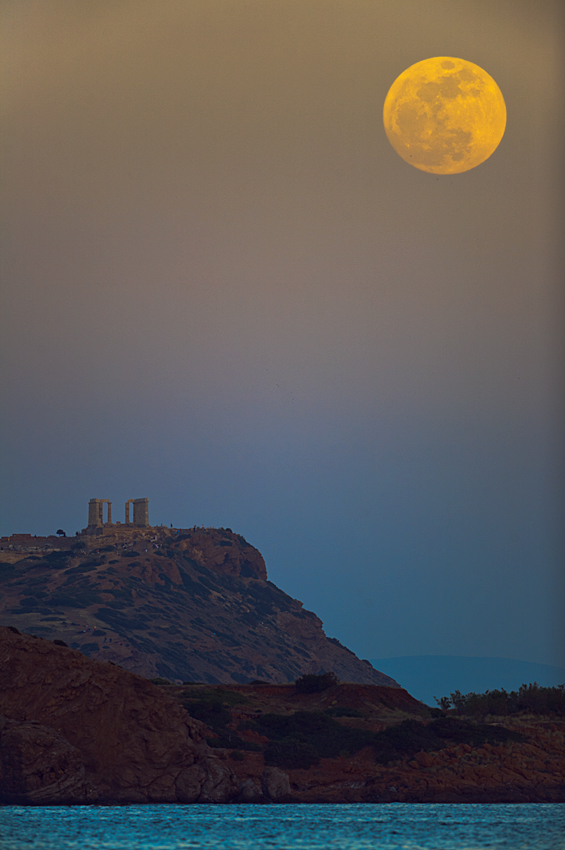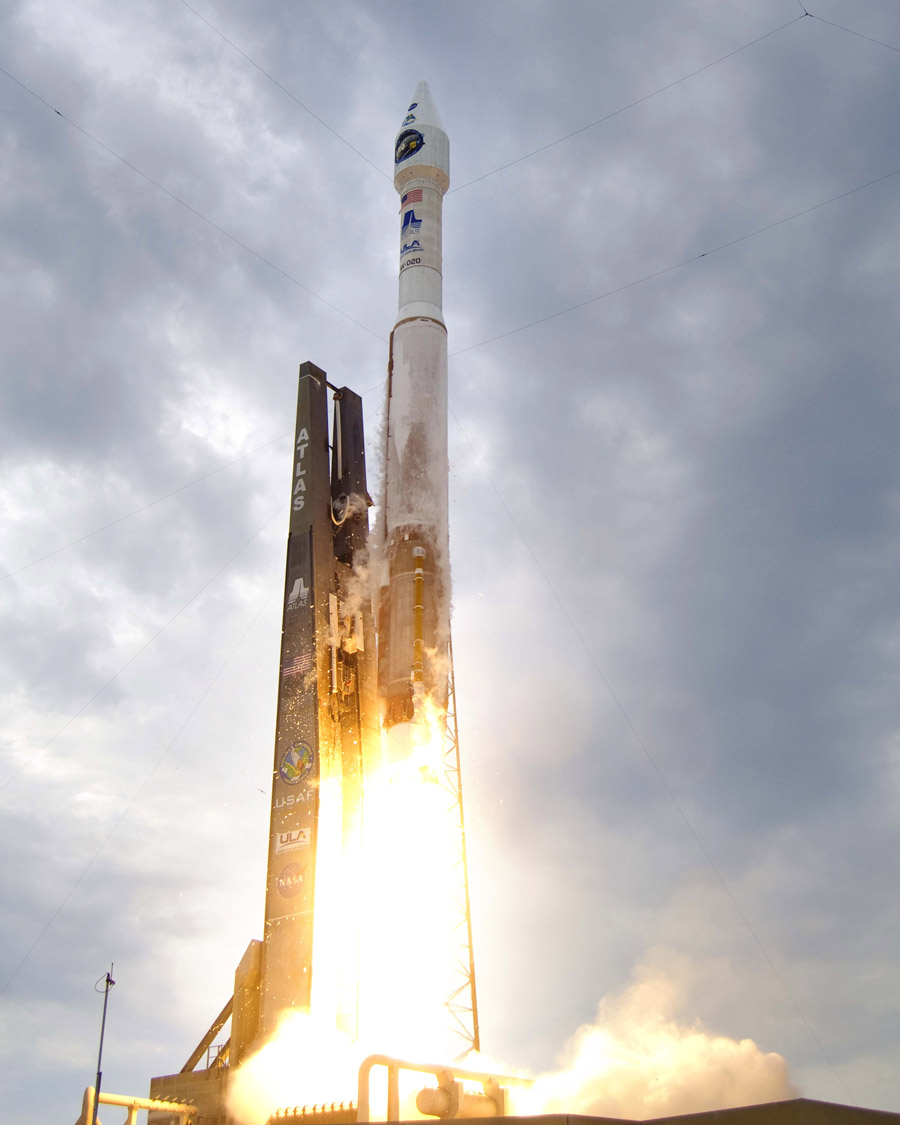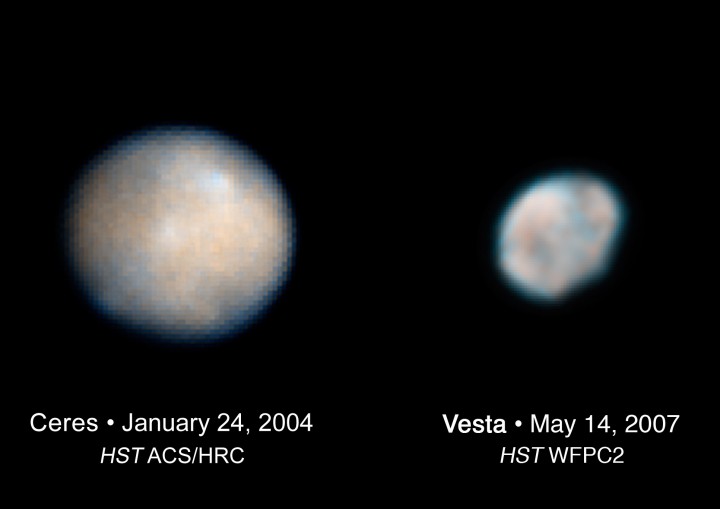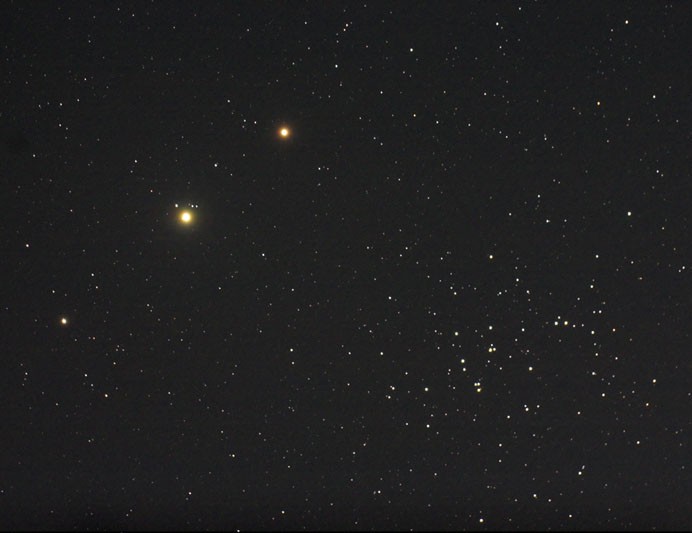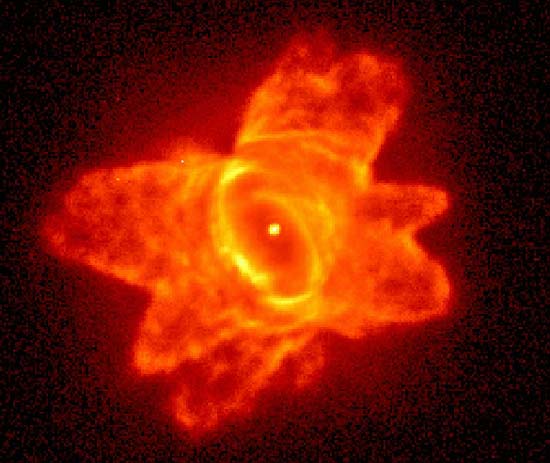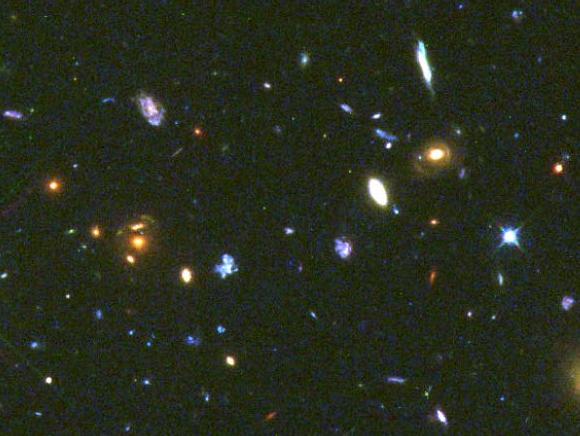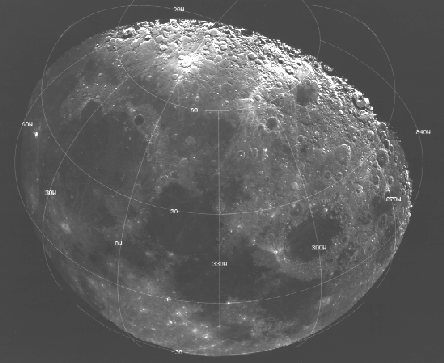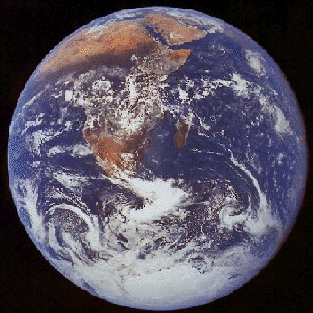| << Previous | Index | Next >> |
2015
Click to play embedded YouTube video.
New Horizons
Video Credit & Copyright: National Space Society
Video Credit & Copyright: National Space Society
2014 Are Saturn's auroras like Earth's? To help answer this question, the Hubble Space Telescope and the Cassini spacecraft monitored Saturn's South Pole simultaneously as Cassini closed in on the gas giant in January 2004. Hubble snapped images in ultraviolet light, while Cassini recorded radio emissions and monitored the solar wind. Like on Earth, Saturn's auroras make total or partial rings around magnetic poles. Unlike on Earth, however, Saturn's auroras persist for days, as opposed to only minutes on Earth. Although surely created by charged particles entering the atmosphere, Saturn's auroras also appear to be more closely modulated by the solar wind than either Earth's or Jupiter's auroras. The above sequence shows three Hubble images of Saturn each taken two days apart.
2013 A big, bright, beautiful Full Moon will rise at sunset on Sunday. Its exact full phase (June 23, 11:32 UT) will occur shortly before it reaches perigee, the closest point to Earth in the Moon's orbit, and make it the largest Full Moon of 2013. But such circumstances are not very rare. The full lunar phase falls near the Moon's orbit perigee about every 14 lunar months. That means the following Full Perigee Moon will be on August 10, 2014, the 14th Full Moon after June 23. On May 5, 2012, 14 Full Moons ago, this inspired telescopic night skyscape captured the Full Perigee Moon rising over Cape Sounion, Greece and the ancient Temple of Poseidon.
2012 Grand spiral galaxies often seem to get all the glory, flaunting their young, bright, blue star clusters in beautiful, symmetric spiral arms. But small, irregular galaxies form stars too. In fact dwarf galaxy IC 2574 shows clear evidence of intense star forming activity in its telltale pinkish regions of glowing hydrogen gas. Just as in spiral galaxies, the turbulent star-forming regions in IC 2574 are churned by stellar winds and supernova explosions spewing material into the galaxy's interstellar medium and triggering further star formation. A mere 12 million light-years distant, IC 2574 is part of the M81 group of galaxies, seen toward the northern constellation Ursa Major. Also known as Coddington's Nebula, the lovely island universe is about 50,000 light-years across, discovered by American astronomer Edwin Coddington in 1898.
2011 Now imaging inner planet Mercury from orbit, the MESSENGER spacecraft wide angle camera has returned this impressive color view of Degas Crater, with a full resolution of 90 meters per pixel. Named for the impressionist painter, the 52 kilometer diameter crater is also shown in an inset context image from the Mariner 10 flyby mission in the mid 1970s. In MESSENGER's view, the crater floor is seen to be filled with an intricate series of cracks, formed as the molten surface resulting from the impact cooled and contracted. Starkly bright, patchy deposits, suggesting compositional differences and freshly exposed material, standout around the crater's central peaks and walls. Details of similar bright deposits are seen in even higher resolution images from MESSENGER.
2010
2009 This rocket is headed for the Moon. Pictured above, a huge Altas V rocket roared off the launch pad last week to start NASA's first missions to Earth's Moon in 10 years. The rocket is carrying two robotic spacecraft. The Lunar Reconnaissance Orbiter (LRO) is scheduled to orbit and better map the Moon, search for buried and hidden ice, and return many high resolution images. Some images will be below one-meter in resolution and include images of historic Apollo landing sites. Exploratory data and images should allow a more informed choice of possible future astronaut landing sites. The Lunar CRater Observation and Sensing Satellite (LCROSS) is scheduled to monitor the controlled impact of the rocket's upper stage into a permanently shadowed crater near the Moon's south pole. This impact, which should occur in about three months, might be visible on Earth through small telescopes.
2008 Big, beautiful, barred spiral galaxy NGC 1300 lies some 70 million light-years away on the banks of the constellation Eridanus. This Hubble Space Telescope composite view of the gorgeous island universe is one of the largest Hubble images ever made of a complete galaxy. NGC 1300 spans over 100,000 light-years and the Hubble image reveals striking details of the galaxy's dominant central bar and majestic spiral arms. In fact, on close inspection the nucleus of this classic barred spiral itself shows a remarkable region of spiral structure about 3,000 light-years across. Unlike other spiral galaxies, including our own Milky Way, NGC 1300 is not presently known to have a massive central black hole.
2007
2006 The heralded alignment of wandering planets Saturn and Mars with the well-known Beehive Cluster took place last weekend on Saturday, June 17. Recorded in dark Arizona skies on that date, this view finds Mars above and right of Saturn - the brightest celestial beacons in the scene - with the Beehive cluster of stars (M44) at the lower right. The two planets appear in conjunction separated by just over half a degree. But about another half a degree along a line joining the two and continuing towards the lower left lies the third brightest object in the image, giant star Asellus Australis. Asellus Australis is also known as Delta Cancri, a middling bright star 136 light-years away in the constellation Cancer, the Crab. Of course, this star's Latin name translates to "Southern Donkey".
2005 What do Saturn's rings look like from the other side? From Earth, we usually see Saturn's rings from the same side of the ring plane that the Sun illuminates them. Geometrically, in the above picture taken in April by the robot Cassini spacecraft now orbiting Saturn, the Sun is behind the camera but on the other side of the ring plane. Such a vantage point gives a breathtaking views of the most splendid ring system in the Solar System. Strangely, the rings have similarities to a photographic negative of a front view. For example, the dark band in the middle is actually the normally bright B-ring. The ring brightness as recorded from different angles indicates ring thickness and particle density of ring particles. Images like these are also interesting for what they do not show: spokes. The unexpected shadowy regions once recorded by the Voyager missions when they passed Saturn in the early 1980s are not, so far, being seen by Cassini. Extra credit: Can you spot the small moon (Prometheus) among the rings?
2004 How did unusual spires form on comet Wild 2? Close inspection of images taken of Comet Wild 2 by the passing Stardust spacecraft in January show numerous strange pinnacles as long as 100 meters long jutting off the surface. The pinnacles were unexpected - close-ups of other comets and asteroids show no such features. In fact, no other Solar System object besides Earth is known to show such unusual structures. Other unusual Wild 2 surface features including long cliffs, deep pits and craters, and numerous active jets. Together with the spires, these features are hypothesized to be indicative of a very rigid surface sculpted by impacts and explosive sublimation. Initially, Wild 2 was expected by many to be held together only quite loosely. Stardust is scheduled to fly by the Earth in 2006 and drop off a sample of Wild 2 for detailed scrutiny.
2003
2002 Two sulfurous eruptions are visible on Jupiter's volcanic moon Io in this color composite Galileo image. On the left, over Io's limb, a new bluish plume rises about 86 miles above the surface of a volcanic caldera known as Pillan Patera. In the middle of the image, near the night/day shadow line, the ring shaped Prometheus plume is seen rising 45 miles above Io while casting a shadow to the right of the volcanic vent. Named for the Greek god who gave mortals fire, the Prometheus plume is visible in every image ever made of the region dating back to the Voyager flybys of 1979 - presenting the possibility that this plume has been continuously active for at least 18 years. This image was recorded in 1997 on June 28 at a distance of 372,000 miles.
2001 Yesterday, for a brief few minutes, a total eclipse of the Sun brought darkness to southern Africa's daytime skies. During this first total solar eclipse of the third millennium webcast sites were swamped, but sun-watchers along the eclipse path enjoyed clear weather and reported fantastic views. Enthusiastic astrophotographer Olivier Staiger recorded these pictures during the eclipse's total phase from Lusaka, Zambia. The large image above shows the Sun's tantalizing inner corona with telltale pinkish prominences around the solar limb, while the inset at the lower right reveals the spiky outer corona. But the inset also captures another celestial beacon sharing the eclipse-darkened heavens, the bright planet Jupiter shining at the lower left. The next total solar eclipse will be on 2002 December 4 ... again in southern African skies.
2000 In our neck of the Galaxy stars are too far apart to be in danger of colliding, but in the dense cores of globular star clusters star collisions may be relatively common. In fact, researchers have evidence that the row of six closely spaced blue stars just below the label in this Hubble Space Telescope image were formed when stars directly collided. Pictured is the central region of NGC 6397, a globular cluster about 6,000 light-years distant, whose stars all formed at about the same time. NGC 6397's massive stars have long since evolved off the main sequence, exhausting their central supplies of nuclear fuel. This should leave the cluster with only old low mass stars; faint red main sequence stars and brighter blue and red giants. However, spectroscopic data show that the indicated stars, descriptively dubbed blue stragglers, are clearly main sequence stars which are too blue and too massive to still be there. Suggestively the stragglers appear to be two and occasionally three times as massive as the lower mass cluster stars otherwise present, supporting evidence for their formation from two and even three star collisions.
1999 How do planetary nebulae acquire their exquisite geometrical shapes? To investigate this, astronomers used the Hubble Space Telescope to image several young planetary nebulae. These nebulae are the outer envelopes of stars like our Sun that have recently been cast away to space, leaving behind a core fading to become a white dwarf. In this photograph in red H-alphacarbon that composes humans is thought to be created by red giant stars and ejected into the cosmos in planetary nebulae like PKS285-02. The complexity of this nebula leads some astronomers to hypothesize that these shells were created by high-speed, collimated outflows during a late phase of this star's evolution.
1998 What created the dust disk in the center of NGC 7052, and what keeps it spinning? Although the disk might appear as a relatively tame "hubcap in space", the unusual center of elliptical galaxy NGC 7052 is probably the remnant of a titanic collision between galaxies. What's more, the disk's spin indicates the tremendous gravity of a massive central black hole. Analysis of this recently released photo by the Hubble Space Telescope indicates that the disk is thousands of light-years across, rotates faster than 100 kilometers per second, at a distance of 150 light-years from the center, and contains more mass than a million Suns. The theorized central black hole is thought to be yet 100 times more massive, and may swallow the entire disk in the next few million years.
1997 This Hubble Space Telescope image of a group of faint galaxies "far, far away" is a snap shot of the Universe when it was young. The bluish, irregularly shaped galaxies revealed in the image are up to eight billion light years away and seem to have commonly undergone galaxy collisions and bursts of star formation. Studying these objects is difficult because they are so faint, however they may provide clues to how our own Milky Way Galaxy formed.
1996 This image is from the voyage of the intrepid Galileo spacecraft as it passed above the Moon's north pole on its long journey to Jupiter. It was made over 60 years after Admiral Byrd became the first to fly over the Earth's north pole. Within a superposed frame of lattitude and longitude lines much of the Moon's familiar face, dominated by smooth dark mare, is brightly lit. Near the pole itself, the harsh shadows reveal a rugged, cratered lunarscape.
1995 In 1972 Astronauts on the United States's last lunar mission, Apollo 17, took this picture looking back at the Earth on their way to the moon. The continents of Antarctica and Africa are visible below the delicate wisps of white clouds.
| << Previous | Index | Next >> |

